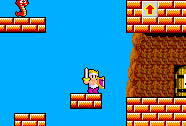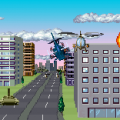A drastic departure from the original, Wonder Boy in Monster Land thrusts our hero into a medieval world, and replaces the tomahawks and grass skirts with swords and shields. You now have a single life and a heart meter, though at the beginning you are granted a single-use resurrection potion. Rather embarrassingly, you spend the first few levels in the arcade version fighting monsters while wearing only underwear. The hero is nicknamed Book (full name: Bocke Lee Temjin), though he only called this in the SMS manual and arcade ending credits, and usually just referred to as Wonder Boy.
Monster Land is a unique game because it combines linear level-based gameplay with RPG elements. Each of the 11 stages is fairly brief, although they are heavily populated with shops, bars, and other folks. Conversations are shown in a first-person view, with the denizens of Monster Land ranging from bartender lizards and demonic fortune tellers to cuddly teddy bears. You can buy new equipment – armor to reduce damage, shields to deflect projectiles, and boots to run faster and jump farther – while more powerful swords are found through optional boss battles. You can also spend your hard earned cash on some booze as well, which both restores health and offers some helpful hints. Getting higher scores will increase the maximum number of hearts. Certain enemies also drop a variety of magic spells, each with a limited number of uses, which include fireballs, tornados, and lightning zaps. However, they are placed in a queue and automatically cast by pressing down on the joystick, so you can’t choose which one to use. Items like gauntlets and helmets also temporarily increase your offense and defense.
Gathering cash is also a bit unusual. As expected, fallen enemies yield gold, but only the first time you kill them – after respawning, they simply give score items. This means you can’t just stand in one place and grind for money. Instead, most cash is found in hidden caches sprinkled throughout each stage (once you find them, there’s an exploitable glitch where you can wiggle the joystick and milk them for substantially more cash than you would normally get). Yet the game actively discourages such exploration, due to a constantly ticking timer, which will deplete one heart from your life meter unless you can find hourglasses to reset it.
There’s also a fair amount of hidden and optional stuff. One of the major stages is a spiked-filled pyramid. At the end is the Sphinx, who asks you a randomized question (some of these are characteristically silly – he likes salad and his favorite Sega game is apparently After Burner). If you don’t know these already, you need to visit a specific bar earlier in the stage and obtain the info from the barkeeper. If you guess correctly you’ll win the fight automatically, otherwise it’s quite a tough battle.
Furthermore, if you want to be properly equipped for the final battle, you’d best uncover as much of the game as possible. The ultimate goal is to find all of the Legendary equipment. Throughout the game, there’s a running subquest as you play messenger for various people, most in secret locations. If you successfully complete it, you’ll be given the option to pick from two secret items: a bell and a ruby. The bell will help you navigate the labyrinthine final stage; the ruby will make the incredibly difficult final battle a little bit easier. But again, the speedy “rush rush“ feeling of the action makes it too easy to miss these quasi-essential items, because it’s impossible to go back to completed levels if you miss a step. Essentially, the game expects you to have played it several times, have all of the secrets and quests memorized, and have an optimal route planned beforehand. It’s also an incredibly tough game. Your sword attacks are short-ranged and not particularly fast, while most enemies are much more agile than your character and can easily gang up on you.
There are some slightly silly things, like the ability to explore underwater areas, walking on the sea floor, while wearing a full suit of armor. The finale also takes a turn for the bizarre. After completing the final dungeon, you discover that the penultimate boss is actually an entity from outer space: the nefarious robot being, Meka Dragon. This sudden change from fantasy to sci-fi became a hallmark of many of the later Wonder Boy games.
The graphics are repetitive, which is to be expected in an arcade game from 1987, but colorful. Changing pieces of equipment will affect the look of your character’s sprite, which is a nice touch. Many enemies, like the snakes and octopi, bear some resemblance to their forms from the first game, but otherwise the visual style is entirely new. The enemies have rather comical expressions on their faces, with bulging eyes or contorted features, which is an amusing recurring element in the series. Annoyingly, in the arcade version, a huge chunk of the screen is taken up by the status window, which makes the action feel cramped.
The arcade version of Wonder Boy in Monster Land was officially only published in Japan, for the Sega System 2 board. However, there are two bootleg versions translated into English that were distributed around the world. An English version was originally made by Westone back in 1987, but Sega chose not to release it. This only became available in 2012, when it appeared on the Wii Virtual Console, XBLA and PSN as a downloadable title. The translation is the same one used in the European computer ports.
Due to the awkward distribution of the arcade game, Monster Land is mostly known for its Sega Master System port. Like most SMS ports, it keeps much of the original’s gameplay, downgrades the graphics only slightly, and even gets rid of the obnoxious status window. All vital data is now at the top of the screen, with all equipment located in the pause menu. The artists were nice enough to give the hero some clothes at the beginning of the game.
The physics have changed slightly, especially in regards to taking damage – in the arcade game, if you are hit multiple times in succession, it resets the invulnerability period and allows you to be juggled, though without taking any damage. This is not present in the Master System version. The multidirectional screen scrolling in larger levels is also gone, replaced by flip-screen movement.
In the arcade game, any enemy that took multiple hits had a life indicator, but in the SMS version this is reserved for boss monsters. Most of the pop-up text, like the windows describing enemy names or item pick-ups, has been removed. However, unlike so many video games that have been censored to remove references to alcohol, you can still buy pints of ale or mead. The level order has changed slightly, and there’s one totally brand new stage featuring a largely abandoned town, inhabited by a couple of new bosses, including a Wizard and Medusa. Roughly half of the soundtrack is missing, with the same two songs used in multiple areas.
The game is technically a bit easier since there are less enemies throughout the stages, and the boss patterns are substantially simplified, but ultimately it’s more frustrating because, unlike the arcade game, you can’t continue. At all. You get a single revival potion, and can buy replacements, but death comes too easily.
The PC Engine version, released by Hudson only in Japan, is a pretty faithful port from the arcade. It was tied in with the popular 1980s property Bikkuriman, which was a “sticker collection“ series. The hero is now known as “Head Rococo“, and all of the sprites and shopkeeper graphics have changed to tie in with Bikkuriman. Otherwise it is very close to the arcade game, missing only minor details, like the door opening animations and the post-level bonus screens. You can also continue through use of a code. There are several other Bikkuriman games (ranging from the Famicom to the Game Boy Color), although none of them are related to the Wonder Boy or Monster World series.
Wonder Boy in Monster Land was also ported to the Famicom, though with a totally different title and altered characters, under the name Saiyuuki World and published by Jaleco. Based on the old Chinese legend, you are the monkey king Goku, off to save ancient China.
While the graphics and music are entirely different, the gameplay is almost exactly the same. Most of the enemies are similar, including the mushrooms and snakes, though the bosses are entirely new, and the crabs are replaced with alligators for some reason. After many boss battles you also free a prisoner, who congratulates you for your efforts. Some of the level designs have changed a bit, shortening many of the areas and adding more shops. Unfortunately, it’s hard to shake the feeling that it’s a sloppy, hacked together product. The new music is atrocious, and enemies can juggle you infinitely while still dealing damage, making one hit kills from bosses frustratingly common.
There was a Saiyuuki World II released as well, which was released in America by Jaleco as Whomp ’Em. In the localized version the main character was changed from Goku to an Indian, and other graphics were altered to fit the Native American theme.
Activision published a number of computer ports in Europe. All of these were based on the arcade version, rather than the Master System release. The ZX Spectrum and Amstrad CPC versions are practically identical, suffering from slow action and the usual limited palette. The C64 version is a definite step up, although it’s still a bit slow. However, the Atari ST and Amiga versions are pretty decent. The colors are a bit off, the action is slightly slow, the scrolling is a bit choppy and the load times are awful.
Perhaps the most bizarre version out of all of this is the mobile version, first developed in 2006 by Hudson in English under the name Super Adventure Island (no relation to the SNES game of the same name), and later released in Japan in 2010 under the name Shin Takahashi-Meijin no Boukenjima (not to be confused with Takahashi-Meijin no Shin Boukenjima, the PC Engine semi-sequel to the original Famicom game). This version replaces Wonder Boy with Master Higgins/Takahashi Meijin.
The graphics are all new and pretty decent too. The swords are now hammers, though they act the same, and while the standard monsters are the same as before, all of the bosses are brand new, at least from a visual standpoint. The shopkeepers are different as well.
Screenshot Comparisons
Shopkeeper Comparisons


